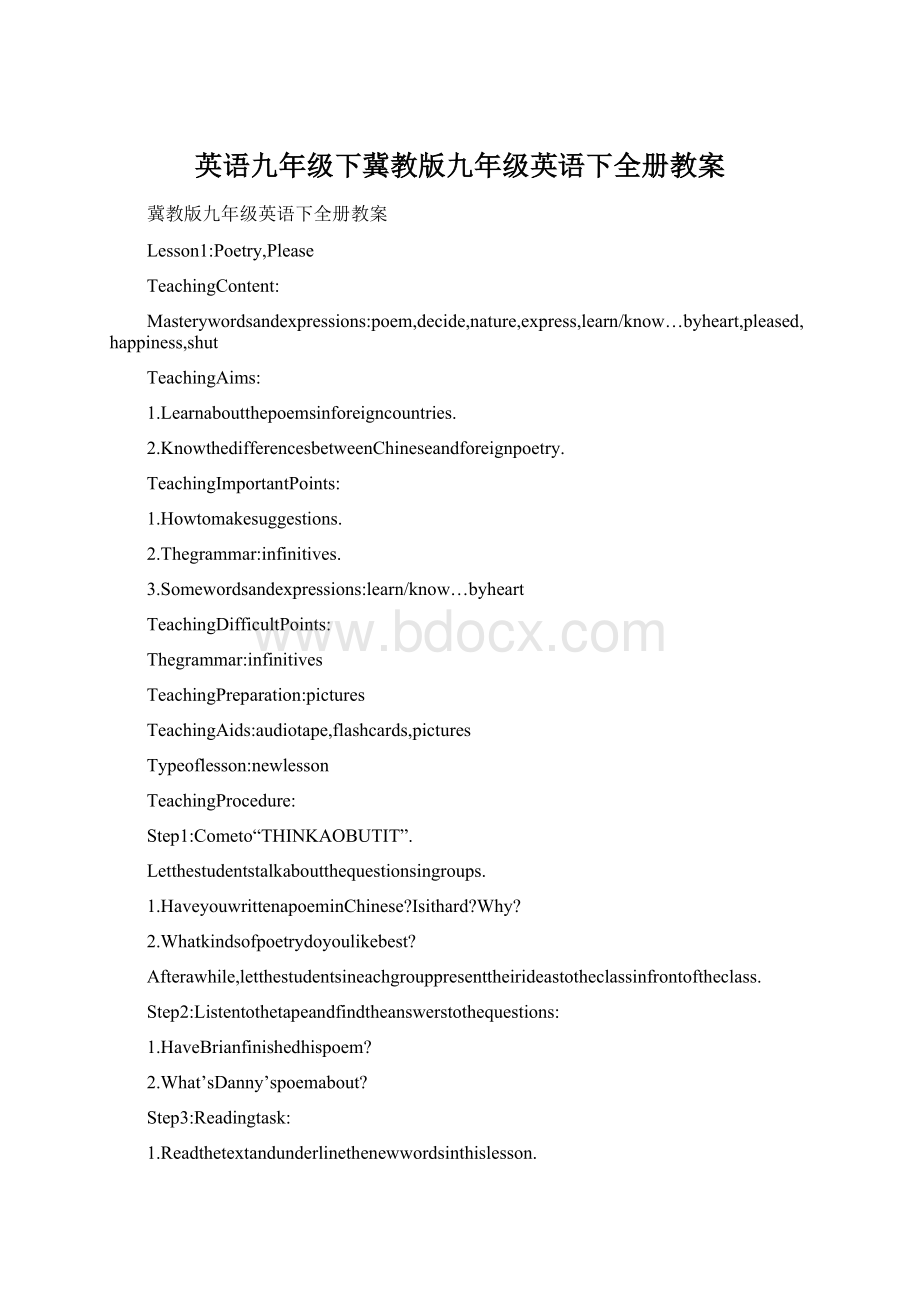英语九年级下冀教版九年级英语下全册教案Word文档格式.docx
《英语九年级下冀教版九年级英语下全册教案Word文档格式.docx》由会员分享,可在线阅读,更多相关《英语九年级下冀教版九年级英语下全册教案Word文档格式.docx(77页珍藏版)》请在冰豆网上搜索。

TeachingPreparation:
pictures
TeachingAids:
audiotape,flashcards,pictures
Typeoflesson:
newlesson
TeachingProcedure:
Step1:
Cometo“THINKAOBUTIT”.
Letthestudentstalkaboutthequestionsingroups.
1.HaveyouwrittenapoeminChinese?
Isithard?
Why?
2.Whatkindsofpoetrydoyoulikebest?
Afterawhile,letthestudentsineachgrouppresenttheirideastotheclassinfrontoftheclass.
Step2:
Listentothetapeandfindtheanswerstothequestions:
1.HaveBrianfinishedhispoem?
2.What’sDanny’spoemabout?
Step3:
Readingtask:
1.Readthetextandunderlinethenewwordsinthislesson.
Presentthemeaningsofthewordswiththehelpofthemediacomputer.Wecanuseourbodylanguageifnecessary.
3.Tellthemainideaofthislesson.
Step4:
Readthetextagainanddecidethestatementsaretrueorfalse.
1.JennywroteaChinesepoem.
2.Brianwroteapoemaboutnature.
3.Dannylearnedhispoembyheart.
Step5:
Dealwiththelanguagepoints.
Howtomakeasuggestion:
Theinfinitives:
Ihaven’tdecidedwhattowriteabout.
Wouldyouliketohearmypoem?
Doyoureallywanttohear?
Idon’tneedtoreadit.
Letthestudentssumtheuseofinfinitivesofthislesson.Thenencouragethemtomakemoresentenceswiththegrammar.
Activities
1.Dividetheclassintoseveralgroups.ThenletthemtranslateaChinesepoemwrittenbyLiBaiorotherfamouspoets.Thencomparethetranslationsofthegroups.Let’sseewhichisthebest.
2.EachgroupwritesanEnglishpoemaboutthefamiliarthingsaroundus.Thenletthemchangethepoemsingroups.Theymaygivetheirownadvicetothepoemswrittenbyothers.
Step6:
DescribethepictureinEnglish.
Askthestudentsworkintheirformalgroups.Thenletthemreadtheirpoemsinclassloudly.
Step7:
Cometo“LET’SDOIT”.
Workwithapartner.Letthestudentstalkaboutthequestion:
whichdoyouthinkismoredifficulttounderstand,EnglishpoetryorChinesepoetry?
AllofthestudentshaveseenmuchChinesepoetry,butfewofthemhaveseenEnglishpoetry.SopresentthestudentsseveralEnglishpoems.Letthemdiscussthemeanideasofthepoems.Thenletthemfinishthetask.
Step8:
Homework
1.Finishofftheactivitybook.
2.GetmoreinformationabouttheEnglishpoetryafterclass.
Summary:
ThestudentsmorelittleoftheEnglish,sothattheteacherprovidesthemmoreinformationabouttheEnglishpoetryisverynecessary.WecanusetheInternettohelpus.Theteachershouldstimulatethestudents’interestsabouttheEnglishpoetry.ThestudentscanhavemoretimetosearchmoreinformationontheInternetafterclass.
Lesson2:
PoemsAboutNature
hill,clear,brave,pale,golden,softly,kiss,noisy
Oralwordsandexpressions:
swiftly,tiny,warmth,scene,related,topic
1.Cultivatethestudents’guessingabilityofthewholetext.
2.EnjoythecharmingoftheEnglishpoetry.
3.ComparethedifferencesbetweentheEnglishandChinesepoetry.
1.LearntheEnglishpoetryaboutnaturebyhearty.
2.KnowhowtowriteanEnglishpoem.
UsewhatwelearntowriteanEnglishpoem.
Cometo“THINKABOUTIT”.
Dividetheclassintoseveralgroups.Talkaboutthenextquestions:
HaveyoureadanypoemsinEnglish?
Whichonedoyoulikebest?
Whatshouldyoudofirstifyouwanttowriteapoemaboutwinter?
Chooseseveralbestpoemsandletthestudentsreadtheminfrontoftheclass.Showsomepicturesofwintertothestudents.Helpthemtofindmorewordstodescribewinter.
Listentothetapeandfillintheblanks.
1.Doesthepoemmakeyouthinkof_______?
2.Youcanwriteapoemabout_______,too.
3.Beforeyoustartwritingyourpoetry,thinkaboutyour_______.
Readthetextandfindthenewwords.
1.Letthestudentsguessthemeaningsofthenewwords.
Mostofthenewwordsarerelatednature.Sopresentsomepicturestothestudentstohelpthemunderstandthenewwords.
2.Asksomestudentstotellthemainideaofthistext.
Dowiththelanguagepoints.
Makesentenceswiththenewwordswelearninthistext.
Askifsomeonecantellastorywiththewordswelearntoday.Encouragethemtostandinfrontoftheclassandtellhisstorytous.
Readingtask
Encouragethestudentstoaskquestionsaboutthistext.
Finishthetaskingroups.Letthestudentsdesignquestionsandexchangethemingroups.Theycanaskquestionslikethis:
1.Whatareyourideasforanaturepoem?
2.Whatcanyoudotodescribeaboutsomething?
Activities.
Workingroups.
Writeapoemaboutthetwopictures.Finishapoem.Theneachstudentinthegroupcorrectitbeforereadingittotheclass.
Cometo“LET’SDOIT!
”
Thetaskissimilartothestep6.Finishitinclass.Trytowriteapoemaboutoneoftheseasons.Theteachershowssomepicturesabouttheseasonstothestudents.
1.Finishofftheexercisesinactivitybook.
2.Goonthenextreadinginthestudentbook.
ItisfunandinterestingtowriteapoeminEnglish.Theteachertriestowriteapoemandpresentsittotheclass.Letthestudentscorrectitiftheyhaveanygoodideas.SomestudentsareinterestedinEnglish,andtheyarealsointerestedinpoems.Sogivethemmorechancestocreatetheirminds.
Lesson3:
SayItinThree
direction,form,poet,simply,asetnumberof,middle,clearly,dark,sleepy,unexpected,frog,feeling
petal,cherry,grebe,MatsuoBasho,Haiku,particular,pattern,set,syllable,interruption,plop,splash,limerick,adverb
1.Cultivatethestudents’readingcomprehension.
2.Knowmoreabouttheforeignculture.
3.ComparethedifferencesbetweentheChineseandJapanesepoems.
1.LearnaboutanoldstyleofJapanesepoem:
Haiku.
2.Knowsomestylesofpoems:
Haiku,NaturePoemandLimerick.
TheoldformofJapanesepoetry:
ShowpicturesofJapanesepoetsandpoems.ThenintroduceHaikutothestudents.Theteachercanfindsomemusictomatchthepoem.
UsuallyHaikusareabout_______.
Haikualwayshas______lines.
ThefirstlineofaHaikuhas_______syllables.
Checktheanswersinclassinoral.
Readthetextandguessthemeaningsofthenewwords.
Sometimessomenewwordsaretoohardtounderstand,sotheteachercanfindsomerelatedpicturestohelpthem.
Ifthestudentsbringsomepicturesaboutnaturetotheclass,letthemshowtheminfrontoftheclass.
Readthetextandfindtheanswerstothequestions:
1.DoHaikustellastory?
2.What’sasyllable?
Cometo“PROJECT”.
1.Dividetheclassintogroupstofinishthetask.
2.Finishthethreepoemsinthetext.Usethesentence:
Ineeda______.Lettheothersgivetheanswers,onestudentwritethewordsdown.
3.Afterfinishingthepoems,readittotheclass.Allthegroupshavedifferentpoems.Dotheysoundfunny?
4.Decideasubjectbyeachgroup.Thenmakeapatternaccordingtothesubject.Thenfinishthepoemasthemodelsinthetext.
5.Readthepoemtotheclass.
Somestudentsmaythinktheforeignpoemsarefunnyandeasy.Theteachermayalsothinkso.Itispossibleforthestudentstocreatepoemslikethosewehavelearnedintheclass.Givethemmorechancestocreatetheirminds.Theteachercantrysomepoems,too.Theclassandtheteachercanfindmuchfuninlearningforeignpoems.
Lesson4:
TheWish
wish,inthemiddleof,stone,friendship,recite
1.Learnhowtosingforeignsongs.
3.Learnaboutthestylesofallkindsofpoemsinothercountries.
1.Masterthemainideaofthesong.
2.Grasptheuseof“without”.
3.Makeasimilarsonglikethis.
Theuseof“without”.
Listentothetapeforseveraltimes.Atthesametime,askthestudentstosingafterit.Testhowlongtheygrasptherhythmofthesong.
Readthesongasapoem.Letthestudentsreadthepoemasalyriclinebyline.
Makeapoemlikethis.
Dividetheclassintoseveralgroups.Makethesimilarthis.Everygroupmakesapoem.Thenpresentittotheclass.Iftheothershaveotherbetterideas,theycangivetheiradvice.
Makesentenceswiththeimportantphrases:
inthemiddle,without.
S1:
Dannysitsinthemiddleoftheclassroom.
S2:
Thereisastoneinthemiddleoftheroad.
S3:
Fishcan’tlivewithoutwater.
S4:
Wecan’tfinishtheworkwithoutyourhelp.
Finishthetaskingroups.
1.Everyoneinthegroupchoosesonepatternofthesepoemsandwritesonebyyourself.
2.Afterwritingthepoem,showittotheothersinthegroup.
3.Eachexamstheothers’poemsandgiveshisadvice.
4.Afterexaminealloftheirpoems,changethemwiththeothergroup.Givetheirreasonableadvice.
5.Theteachergivesthemchancestoexpressthemselves.
Homework.
1.Finishofftheexercisesintheactivitybook.
ThestudentsarefamiliartotheChinesepoetry,buttheforeignonesarehardforthem.Whenthestudentspractice,theteachershouldgivethemahandifnecessary.ItisachallengefortheChinesestudentstowriteforeignpoems.EncouragethemmoreinordertostimulatetheirinterestsoflearningEnglish.
Lesson5:
That’saFunnyLimerick!
both…and…
blank,motion
1.Cultivatethestudents’abilityoflearningbythemselves.
2.Masteroneofthepatternsofforeignpoems.
3.ComparethedifferencesbetweentheChineseandforeignpoetry.
1.Knowmoreaboutthelimerick.
2.Learnmorewordsaboutdescribingweight,size,feelingandage.
Knowhowtowritealimerick.
Letthestudentsanswerthequestionsinclassinoral.
1.AskseveralstudentstosayfunnysayingsinEnglish.Iftheycan’texpressthemselvesinEnglish,theycansaytheminChinese.
2.